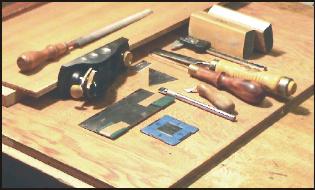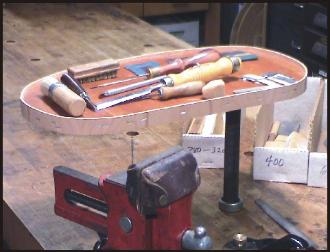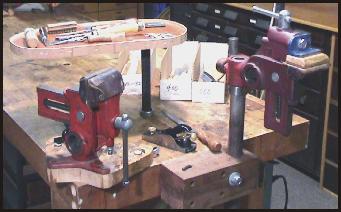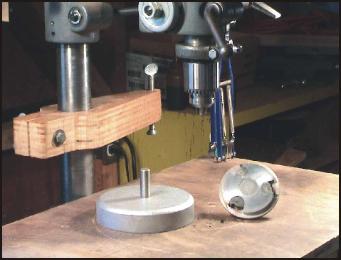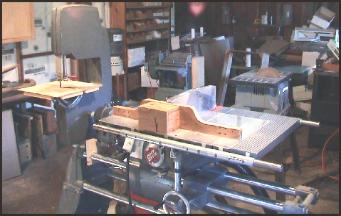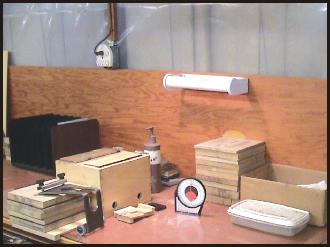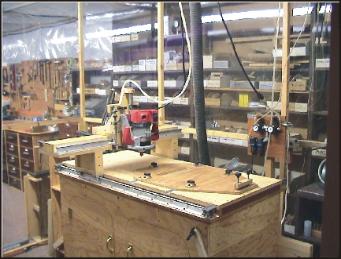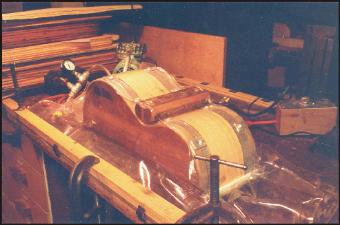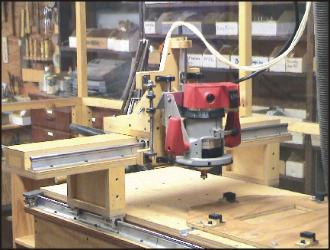Tools and machines
Here are some photos of the tools and machines that I use.
~ Click on the photo to enlarge it ~ Use your back arrow to return ~
The first thing I do with students is to find
out what tools they have, and what mix of
hand and power tools they want to work
with. I want to teach skills that you can
take home and put to use, so we work with
the combination that best suits your
inclinations.
Often, people want to invest in tools and
machines, and I'm happy to give advice on
the choices. Fortunately, guitar making can
be done quite efficiently with home shop
equipment that is not expensive.
out what tools they have, and what mix of
hand and power tools they want to work
with. I want to teach skills that you can
take home and put to use, so we work with
the combination that best suits your
inclinations.
Often, people want to invest in tools and
machines, and I'm happy to give advice on
the choices. Fortunately, guitar making can
be done quite efficiently with home shop
equipment that is not expensive.
I have set up to make guitars for a living,
so I've made a lot of jigs, fixtures, gadgets,
and gizmos that work in conjunction with
power tools. But, my hand tools are still
the most important ~ plane, scrapers,
chisels, rasps and files, sanding blocks ~
all of the fine work that goes into making a
beautiful instrument is done with these.
so I've made a lot of jigs, fixtures, gadgets,
and gizmos that work in conjunction with
power tools. But, my hand tools are still
the most important ~ plane, scrapers,
chisels, rasps and files, sanding blocks ~
all of the fine work that goes into making a
beautiful instrument is done with these.
This pivoting tool tray was inspired by a
visit to my dentist, by sheer coincidence a
woodworking student of mine from long
ago. It is mounted on ¾ inch water pipe,
with one of those standard flanges. My
bench dog holes are 1-1/16 inch diameter
to accommodate "plumbers delight"
devices, like pipe clamps.
visit to my dentist, by sheer coincidence a
woodworking student of mine from long
ago. It is mounted on ¾ inch water pipe,
with one of those standard flanges. My
bench dog holes are 1-1/16 inch diameter
to accommodate "plumbers delight"
devices, like pipe clamps.
And remember the Versa-Vise! I've used
the one on the left since 1963. It's been
re-issued by Grizzly Tools as the "Parrot"
vise. It not only holds guitar parts, it holds
fixtures that hold the guitar at various
stages of construction. That's another one
on the right, on a post that goes up and
down. I've installed a pivoting jaw on it.
the one on the left since 1963. It's been
re-issued by Grizzly Tools as the "Parrot"
vise. It not only holds guitar parts, it holds
fixtures that hold the guitar at various
stages of construction. That's another one
on the right, on a post that goes up and
down. I've installed a pivoting jaw on it.
You can surface wide, glued-up backs and
soundboards on a drill press using the
Wagner Safety Planer, on the right, and
smooth them with John Gilbert's precision
disc sander, on the left. I use a shop made
hold down system to keep the work flat
against the table.
soundboards on a drill press using the
Wagner Safety Planer, on the right, and
smooth them with John Gilbert's precision
disc sander, on the left. I use a shop made
hold down system to keep the work flat
against the table.
It would be pretty hard to over emphasize
the importance of sharpening. Most
woodworkers have never enjoyed using a
really sharp tool, and once you do, you
see what all the shouting's about. Since I
sharpen frequently, I want to do it fast,
accurately, and to a high degree of
sharpness. Go back to the Home page, and
have a look at Double Bevel Sharpening.
the importance of sharpening. Most
woodworkers have never enjoyed using a
really sharp tool, and once you do, you
see what all the shouting's about. Since I
sharpen frequently, I want to do it fast,
accurately, and to a high degree of
sharpness. Go back to the Home page, and
have a look at Double Bevel Sharpening.
Here's my trusty Shopsmith Mark V with a
bandsaw set up on it. My 12 inch Parks
planer is in the background. I have two
other table saws, but the Shopsmith comes
in for a lot of use because of its versatility.
bandsaw set up on it. My 12 inch Parks
planer is in the background. I have two
other table saws, but the Shopsmith comes
in for a lot of use because of its versatility.
The sharpening set-up that I use has its
own spot in the shop. I sharpen scrapers
on stones as well.
own spot in the shop. I sharpen scrapers
on stones as well.
I'm particularly proud of a machine that
I've built myself that I call a "Router Mill",
because it's like a vertical milling machine
for wood. This is the fourth one I've made,
and I use it for many production
operations. It's not a project for the faint of
heart however; it took me three months,
and cost me around $2000.
What the machine does is allow precise
control of the movement of a router in
three axes. It has straight lines, right
angles, and flat planes built into it, and any
combination of locks and stops can be
used to limit travel in any direction.
I've built myself that I call a "Router Mill",
because it's like a vertical milling machine
for wood. This is the fourth one I've made,
and I use it for many production
operations. It's not a project for the faint of
heart however; it took me three months,
and cost me around $2000.
What the machine does is allow precise
control of the movement of a router in
three axes. It has straight lines, right
angles, and flat planes built into it, and any
combination of locks and stops can be
used to limit travel in any direction.
The up and down motion of the router is
controlled by a low friction air cylinder so
that it effectively floats on a cushion of air.
By allowing the router complete freedom
of movement it can be used as a carving
duplicator.
By locking its vertical movement I use it as
a surfacing machine for tops and backs.
Since the vacuum chuck that holds the part
is faced off with the router, cancelling out
any error in its travel, the accuracy is quite
remarkable.
controlled by a low friction air cylinder so
that it effectively floats on a cushion of air.
By allowing the router complete freedom
of movement it can be used as a carving
duplicator.
By locking its vertical movement I use it as
a surfacing machine for tops and backs.
Since the vacuum chuck that holds the part
is faced off with the router, cancelling out
any error in its travel, the accuracy is quite
remarkable.
I use vacuum for a number of clamping and
work holding jobs around the shop. Here it
is used, with a shop made vinyl bag, to
press the veneers of a side to the mold.
work holding jobs around the shop. Here it
is used, with a shop made vinyl bag, to
press the veneers of a side to the mold.
I prefer to laminate sides, as they are
stronger, and smoother, and can be made
safely from figured side wood. I glue them
with boatbuilders epoxy, that is
formulated especially for use with wood.
It gives plenty of time for assembly, and
doesn't introduce any water that can cause
warpage.
The top of the line classic guitars made by
Ramirez, and the world class steel string
acoustics, made by Ervin Somogyi, use
laminated sides.
stronger, and smoother, and can be made
safely from figured side wood. I glue them
with boatbuilders epoxy, that is
formulated especially for use with wood.
It gives plenty of time for assembly, and
doesn't introduce any water that can cause
warpage.
The top of the line classic guitars made by
Ramirez, and the world class steel string
acoustics, made by Ervin Somogyi, use
laminated sides.
Used refrigerator compressors, available
from appliance repair places, make good
vacuum pumps. In fact, you can set up for
laminating sides for less than the cost of
building a heated side bending machine.
from appliance repair places, make good
vacuum pumps. In fact, you can set up for
laminating sides for less than the cost of
building a heated side bending machine.
I've bent lots of sets of sides by the
traditional method with a hot pipe, and can
show you how to do it that way if you
prefer.
traditional method with a hot pipe, and can
show you how to do it that way if you
prefer.
____________________________________
